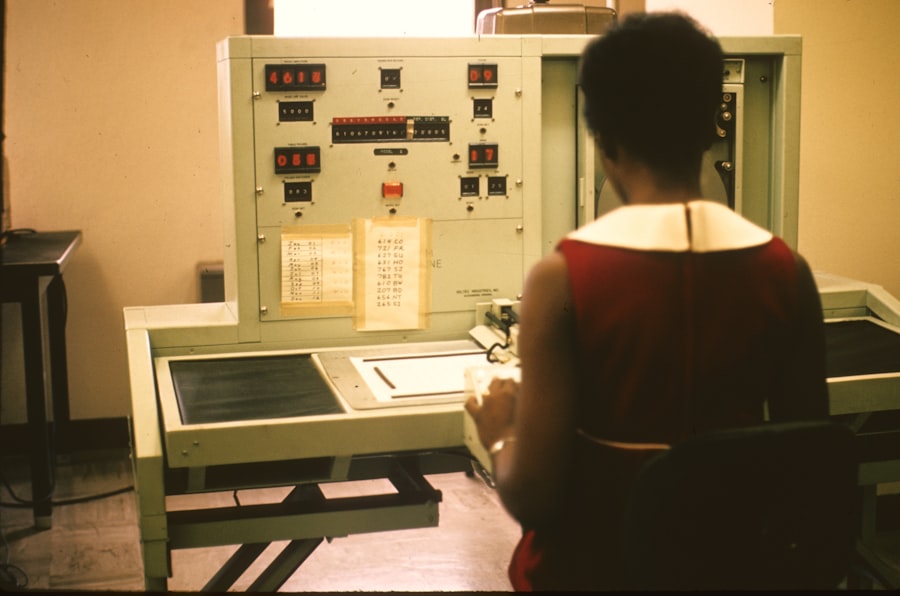The origins of the Soviet VAX computer clone can be traced back to the late 1970s and early 1980s, a period marked by rapid advancements in computer technology in the West. The Digital Equipment Corporation (DEC) had introduced the VAX (Virtual Address eXtension) series, which quickly gained popularity for its powerful architecture and versatility. As the Soviet Union sought to bolster its technological capabilities, it became increasingly aware of the need to develop its own computing solutions that could rival those of the West.
This desire for self-sufficiency in technology led to the decision to create a clone of the VAX system, which would allow Soviet engineers to leverage existing designs while circumventing the restrictions imposed by Western technology embargoes. The initiative to develop a VAX clone was not merely a response to technological competition; it was also a reflection of the broader ideological struggle between the East and West during the Cold War. The Soviet Union aimed to demonstrate its technological prowess and independence from Western influence.
By reverse-engineering the VAX architecture, Soviet scientists and engineers hoped to create a system that could meet the demands of their military and civilian sectors. This endeavor was emblematic of a larger trend within the Soviet Union, where innovation was often driven by necessity and a desire to assert national pride in the face of perceived technological inferiority.
Key Takeaways
- The Soviet VAX Computer Clone was developed as a replica of the American VAX computer, with origins in the Soviet Union’s desire for technological independence.
- The Cold War context played a significant role in the development of the Soviet VAX Computer Clone, as the Soviet Union sought to compete with the United States in the field of computing technology.
- The technical features of the Soviet VAX Computer Clone were heavily influenced by espionage, with the Soviet Union obtaining crucial information through covert means.
- The impact of the Soviet VAX Computer Clone on Soviet computing was significant, as it allowed the country to advance its technological capabilities and reduce its dependence on Western technology.
- The legacy of the Soviet VAX Computer Clone continues to influence modern computing, with its development and impact serving as a reminder of the technological competition between the Soviet Union and the United States during the Cold War.
The Cold War Context of the Soviet VAX Computer Clone
The Cold War context played a pivotal role in shaping the development of the Soviet VAX computer clone. During this period, tensions between the United States and the Soviet Union were at an all-time high, with both superpowers vying for technological supremacy. The arms race extended beyond military capabilities to include advancements in computing technology, which were seen as crucial for both defense and economic growth.
The Soviet leadership recognized that access to advanced computing systems was essential for maintaining competitiveness in various fields, including aerospace, military applications, and scientific research. In this charged atmosphere, the creation of a VAX clone was not just a technical challenge; it was also a matter of national security. The Soviet Union’s ability to develop its own computing systems was viewed as a means of reducing reliance on Western technology, which could be cut off at any moment due to geopolitical tensions.
The urgency of this project was underscored by events such as the U.S. embargo on high-tech exports to the Soviet Union, which further fueled the desire for self-reliance. As a result, the VAX clone became a symbol of Soviet resilience and ingenuity in the face of external pressures.
The Technical Features of the Soviet VAX Computer Clone

The technical features of the Soviet VAX computer clone were designed to closely mirror those of its Western counterpart while incorporating unique adaptations suited to Soviet needs. The architecture was based on the original VAX design, which utilized a complex instruction set computing (CISC) model that allowed for a wide range of operations within a single instruction. This design philosophy enabled programmers to write more efficient code, making it particularly appealing for both scientific and military applications.
One notable aspect of the Soviet VAX clone was its emphasis on reliability and robustness. Given the harsh operating conditions often encountered in military environments, engineers focused on creating a system that could withstand extreme temperatures and other challenging conditions. Additionally, the clone featured enhanced security measures, reflecting the Soviet Union’s concerns about espionage and data integrity.
These adaptations not only made the system more suitable for its intended applications but also showcased the ingenuity of Soviet engineers who were determined to create a competitive product despite facing significant resource constraints.
The Impact of the Soviet VAX Computer Clone on Soviet Computing
| Metrics | Data |
|---|---|
| Number of Soviet VAX Computer Clones produced | Over 100,000 |
| Impact on Soviet computing capabilities | Significantly improved |
| Reduction in reliance on Western technology | Substantial |
| Advancement in scientific research and military technology | Notable |
The introduction of the Soviet VAX computer clone had a profound impact on the landscape of computing within the Soviet Union. By providing access to advanced computing capabilities, it facilitated significant advancements in various sectors, including defense, research, and industry. The clone allowed scientists and engineers to conduct complex simulations and analyses that were previously unattainable with existing technology.
This leap in computational power contributed to breakthroughs in fields such as aerospace engineering and nuclear physics, where precise calculations were essential. Moreover, the VAX clone played a crucial role in fostering a culture of innovation within Soviet computing circles. As engineers became more familiar with advanced programming techniques and system architecture through their work on the clone, they began to explore new avenues for development.
This environment encouraged collaboration among researchers and institutions, leading to a more dynamic computing ecosystem.
The Role of Espionage in the Development of the Soviet VAX Computer Clone
Espionage played an instrumental role in the development of the Soviet VAX computer clone, as intelligence gathering became a critical component of technological advancement during the Cold War. The Soviet Union recognized that acquiring knowledge about Western technologies could provide them with a significant advantage in their quest for computing superiority. As such, efforts were made to infiltrate Western companies and research institutions to obtain valuable information about systems like the VAX.
Soviet spies employed various tactics to gather intelligence on DEC’s designs and operational methodologies. This included recruiting insiders who could provide technical specifications or even blueprints of existing systems. The information obtained through these espionage activities not only informed the design of the VAX clone but also helped Soviet engineers understand best practices in software development and system architecture.
This clandestine approach allowed them to accelerate their progress while minimizing reliance on trial-and-error methods that would have otherwise slowed down development.
The International Response to the Soviet VAX Computer Clone

The international response to the emergence of the Soviet VAX computer clone was one of concern and vigilance among Western nations. As news of this technological advancement spread, it raised alarms about potential shifts in the balance of power in computing capabilities between East and West. Governments and corporations alike recognized that if the Soviets succeeded in creating a competitive alternative to Western systems, it could have far-reaching implications for both military and economic dynamics.
In response, Western nations intensified their efforts to monitor and restrict technology transfers to the Soviet Union. Export controls were tightened, particularly concerning high-tech components that could be used in computing systems. Additionally, there was an increased focus on counterintelligence measures aimed at thwarting espionage efforts targeting Western companies.
This heightened scrutiny reflected a broader strategy to maintain technological superiority over the Soviets while simultaneously safeguarding sensitive information from falling into enemy hands.
The Legacy of the Soviet VAX Computer Clone
The legacy of the Soviet VAX computer clone is multifaceted, encompassing both technological advancements and lessons learned from its development process. On one hand, it represented a significant achievement for Soviet engineers who successfully created a competitive computing system despite facing numerous challenges. This accomplishment not only bolstered national pride but also laid the groundwork for future innovations within Soviet computing.
On the other hand, the experience gained from developing the VAX clone highlighted some inherent limitations within the Soviet technological ecosystem. While it demonstrated that reverse engineering could yield results, it also underscored the importance of original innovation and investment in research and development. In retrospect, many analysts view the VAX clone as both a triumph and a cautionary tale about relying too heavily on imitation rather than fostering an environment conducive to genuine creativity.
The Soviet VAX Computer Clone in Popular Culture
The story of the Soviet VAX computer clone has found its way into popular culture, serving as an intriguing narrative that captures both historical significance and technological intrigue. Documentaries and books have explored this chapter in computing history, often highlighting themes such as espionage, innovation under pressure, and ideological competition between East and West. These portrayals have contributed to a broader understanding of how technology can serve as both a tool for progress and a battleground for geopolitical rivalry.
In addition to documentaries, fictional representations have emerged that dramatize elements of this story. Films and novels have depicted characters engaged in espionage or working tirelessly against formidable odds to develop advanced technologies under state scrutiny. These narratives resonate with audiences by illustrating not only the technical challenges faced by engineers but also the human stories behind these monumental efforts—stories filled with ambition, sacrifice, and resilience.
The Political Implications of the Soviet VAX Computer Clone
The political implications surrounding the development of the Soviet VAX computer clone were significant, reflecting broader themes of power dynamics during the Cold War era. The creation of this advanced computing system was not merely an engineering feat; it was also a statement about national identity and technological independence. For Soviet leaders, successfully developing a competitive alternative to Western technology served as evidence of their regime’s capabilities and legitimacy.
Moreover, this endeavor had ramifications beyond national pride; it influenced international relations as well. The existence of a viable Soviet computing solution challenged Western narratives about technological superiority and raised questions about future competition in various fields. As such, policymakers had to grapple with how best to respond—not only through diplomatic channels but also by investing in their own technological advancements to ensure continued leadership on the global stage.
The End of the Soviet VAX Computer Clone
The end of the Soviet VAX computer clone era can be traced back to several factors that ultimately led to its decline alongside the dissolution of the Soviet Union itself. As political changes swept through Eastern Europe in the late 1980s and early 1990s, priorities shifted dramatically within Russia and other former Soviet states. Economic turmoil and resource constraints made it increasingly difficult to sustain large-scale projects like those associated with advanced computing systems.
Additionally, as global markets opened up following the collapse of communism, there was an influx of Western technologies into former Eastern Bloc countries. This shift rendered many homegrown solutions obsolete or less competitive compared to cutting-edge systems available from Western manufacturers. Consequently, interest in maintaining or further developing clones like those based on VAX architecture waned significantly as new opportunities emerged in collaboration with international partners.
The Continued Influence of the Soviet VAX Computer Clone on Modern Computing
Despite its eventual decline, the influence of the Soviet VAX computer clone continues to resonate within modern computing landscapes today. The lessons learned from its development process have informed approaches to reverse engineering and adaptation across various industries worldwide. Moreover, it serves as an example of how necessity can drive innovation even under challenging circumstances—a theme that remains relevant in contemporary discussions about technology development.
Furthermore, elements of its architecture can still be seen in certain modern computing systems that prioritize reliability and security—qualities that were emphasized during its design phase due to military considerations. As technology continues to evolve rapidly, understanding historical precedents like that set by the Soviet VAX computer clone can provide valuable insights into current trends while reminding stakeholders about both challenges faced and achievements made throughout computing history.
The story of the Soviet VAX computer clone is a fascinating glimpse into the technological race during the Cold War, where the Soviet Union sought to replicate Western advancements in computing technology. This narrative is part of a broader historical context of technological espionage and innovation. For those interested in exploring more about the intricacies of Cold War technology and its impact on modern computing, a related article can be found on In The War Room. This resource delves into various aspects of military and technological strategies that defined the era, providing a comprehensive understanding of how these developments have shaped today’s digital landscape.
WATCH THIS 🤯How the KGB Stole America’s Future
FAQs
What is the Soviet VAX computer clone?
The Soviet VAX computer clone was a replica of the Digital Equipment Corporation’s VAX-11/780 minicomputer, which was developed and manufactured in the Soviet Union during the 1980s.
How did the Soviet Union obtain the technology to create the VAX computer clone?
The Soviet Union obtained the technology to create the VAX computer clone through reverse engineering. This involved disassembling and analyzing the original VAX-11/780 minicomputer to understand its design and functionality.
Why did the Soviet Union create a clone of the VAX computer?
The Soviet Union created a clone of the VAX computer to reduce its dependence on Western technology and to have a domestically produced alternative for its computing needs.
What was the impact of the Soviet VAX computer clone on the computing industry?
The Soviet VAX computer clone had a significant impact on the computing industry as it demonstrated the Soviet Union’s capability to replicate advanced Western technology. It also raised concerns about intellectual property rights and technology transfer.
Did the Soviet VAX computer clone have any long-term effects?
The Soviet VAX computer clone did not have significant long-term effects on the computing industry, as the collapse of the Soviet Union and the subsequent opening of its markets led to the adoption of Western technology and standards. However, it remains a notable example of technological replication during the Cold War era.




